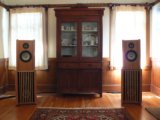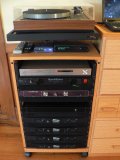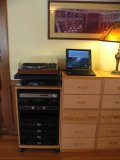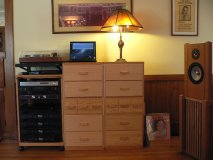Orion Photo gallery
click image to enlarge

|

|

|

|

|

|

|

|

|

|

|

|

|

|

|

|

|

|

|

|

|

|

|

|

|

|
The rightmost photo in the first row is of the Orion pair set up to be listened to in comparison to Jason's own system, which currently consists of two large Tom Danley Unity Horns (like the ones show on William Cowan's audio page) , with four 15" bass drivers (not visible in photo) mounted in the sonotubes behind. Neither the array of 15" drivers or the old Klipsch La Scalas that you see in this photo are being listened to at this time. Jason is actually just using the La Scalas as stands for the Unity Horns.
This Orion pair has been an exciting (and terrifying) project for me. As you may know, this is not a cheap project, and once you've spent the money, there's no turning back. I have to say that I'm quite thrilled with the way it has turned out.
The two photos on the third row are of my electronics stack. I use four Hafler P1000, 50 wpc power amps to drive the Orion pair with. The Orion design spec calls for 8 channels of identical amplification, and instead of spending approximately $1600 for an ATI multichannel amp as suggested in the Orion web page, I took my time and purchased these amps, one at a time, on EBay. I have about $600 total invested in the four amps.
Rackmounting is a very compact and neat way of packing your gear in. My rackmount unit and my record storage units are from Per Madsen Design . The preamp is a Bryston .5B and the CD player is actually a Samsung DVD player which plays CD, SACD and DVD-audio. I have abandoned FM and am instead using a Squeezebox for playing Internet radio. Lastly I now keep a laptop connected to take CD grade digital transfers from analog sources using a Xitel inport.
My Linn turntable sits on a Target wall-mount, which really is just about the very best way to situate a turntable because it provides the very best isolation from movement of the floor. If you own your home and don't mind putting lag screws into the studs in your wall, a turntable wall mount will be worth every penny you put into it.
Another fun place to shop is Parts Express. That's where I got the 1/2 meter long interconnects I'm using as well as the some 130 feet of 14 gauge speaker wire I needed. When you have 8 channels of amplification with speaker wire running to each driver, that's a lot of speaker wire. Just imagine if I were using some fancy hoo-hah wire at $100/foot! The wires are terminated at the speakers with spade lugs I got from Ace Hardware and are connected to a standard terminal strip. You can see me wiring up the speakers to the terminal strips in the leftmost photo in the top row.
The most important parts of the audio chain are the beginning and the end. The beginning is the microphones as well as the engineering techniques and equipment being applied to store the signal. By the time the recording has reached my home, half of the audio chain has already been traversed. I've always felt that the best place to put your audio dollars is in the end of the chain, the loudspeakers. In this case, it's not only the loudspeakers, it's also the associated crossover and amp array, as it's a totally engineered system. I am quite satisfied with how this has turned out, and would be happy to set the Orion pair up against anything the finest audio salons have to offer.
Drop a line if you feel so inclined. It's always fun to correspond with other audiophiles.
Regards,
Russ Button